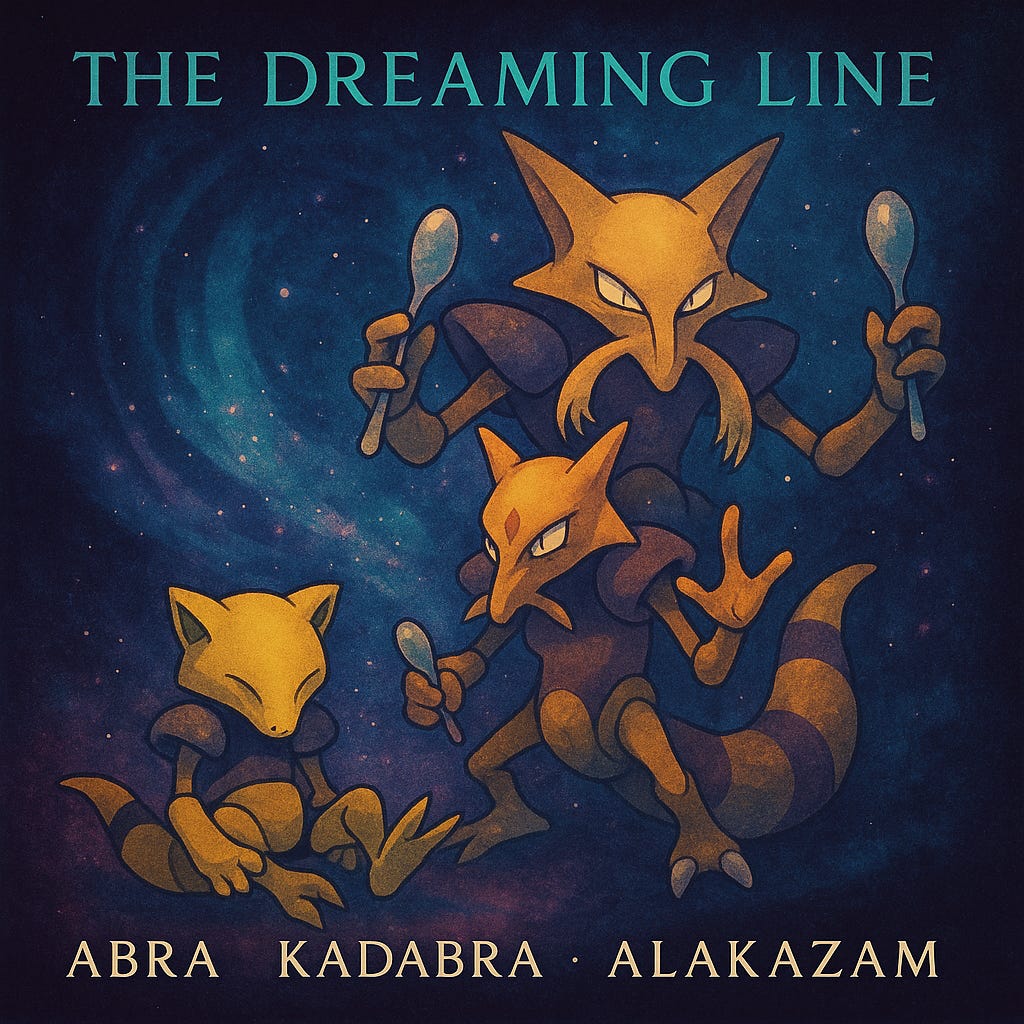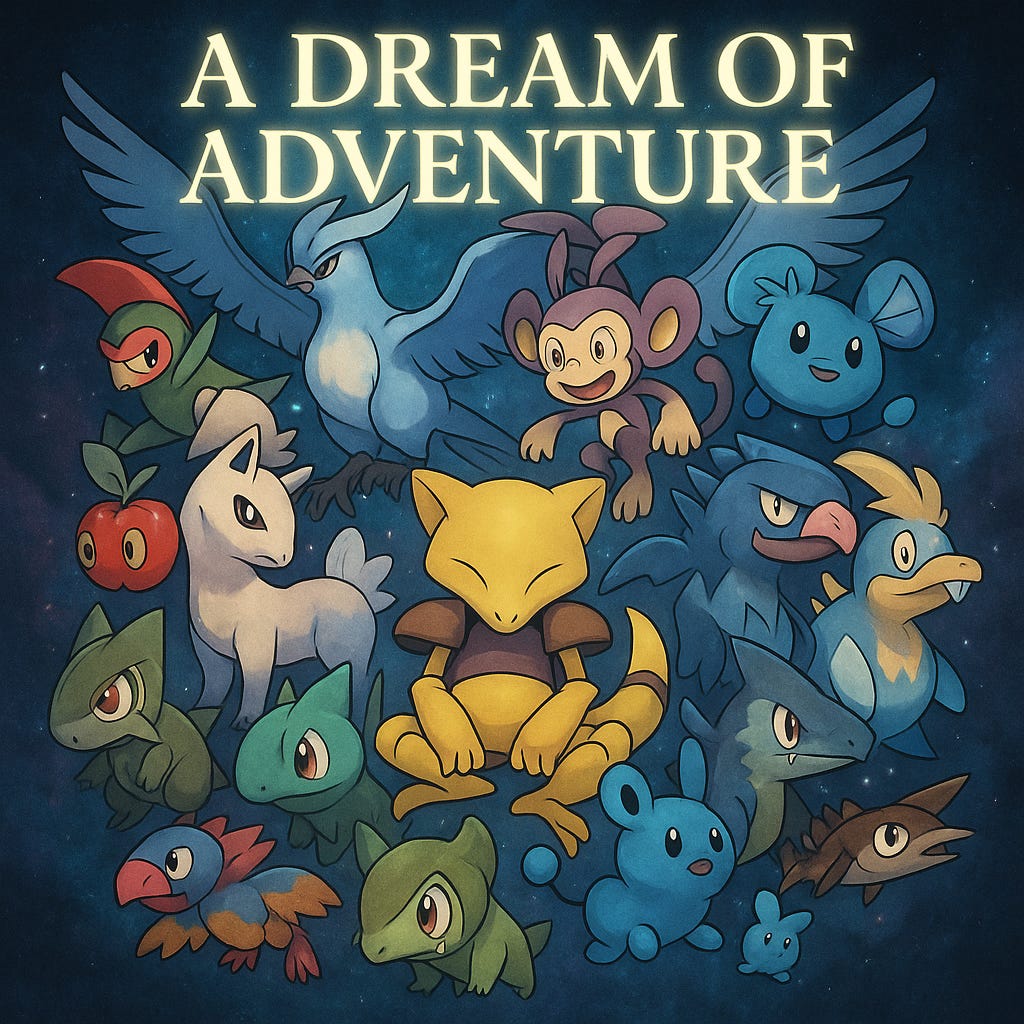“The Dreaming Line”
Abra sleeps in trembling light,
Eyes closed tight to dodge the fight.
Whispers hum where shadows flow,
A thousand miles in one thought’s glow.
Kadabra rises, staff in hand,
Bending spoons like grains of sand.
Mind sharp as a dagger’s gleam,
Reality warps beneath his dream.
Then Alakazam, the sage of night,
Two spoons blazing with psychic might.
A mind so vast, no scroll can chart,
He carries the cosmos inside his heart.
From fragile sleep to wisdom’s flame,
Three stages whisper the same name:
To wake, to shape, to understand—
The dreamer guides the mortal land.
Lore
In the Pokémon world, few evolutionary lines carry the same air of mystery, controversy, and philosophical weight as Abra, Kadabra, and Alakazam. They are not creatures that smash rocks or breathe fire; they are creatures that bend reality itself. Their story reads less like the design of a children’s game and more like a parable of consciousness, illusion, and the fragile threshold between human and other.
The Sleeper Who Shapes Reality
Abra, the first stage, is deceptively simple. A small foxlike figure with closed eyes, it spends nearly its entire life asleep. The Pokédex reports that it sleeps for eighteen hours a day—yet even in that vulnerable state, it can teleport away from any threat. Abra lives in a dream and still survives in the waking world, a paradox that mirrors the way human thought drifts between imagination and action.
What makes Abra so compelling is not what it does, but what it suggests: a creature whose real life is internal, psychic, liminal. Is Abra ever awake in the sense we understand it, or does it only visit our world as a reflex of danger, an instinctive flicker of displacement? Abra doesn’t battle—it flees. And in that refusal lies its strangeness: survival through absence, power through withdrawal.
The Magician and the Metamorphosis
At level sixteen, Abra becomes Kadabra, and the lore abruptly deepens. Here, one of the strangest entries in the Pokédex: “It happened one morning — a boy with extrasensory powers awoke in bed transformed into Kadabra.”
This is not just Pokémon trivia; this is metamorphosis of Kafkaesque proportions. The line suggests Kadabra is, or once was, human. Does evolution here mean growth—or transfiguration, the breaking of a boundary between our species and theirs? It is myth smuggled into a game cartridge: unsettling, folkloric, impossible to ignore.
Kadabra also carries a spoon. Not as a trick, but as an amplifier of psychic energy. The design alludes to stage magicians bending spoons, yet here the illusion becomes real. Kadabra warps clocks, disrupts electricity, and leaves a trail of distortion. Where Abra only bent space, Kadabra bends perception itself.
That tension—between the human who pretends and the Pokémon who embodies—sits at the heart of its mythos.
The Mind Without Limits
Alakazam arrives not through training but through exchange, a Pokémon whose evolution is literally tied to a transaction between players. Fitting, perhaps, for a being that embodies knowledge shared, intelligence multiplied.
The Pokédex describes Alakazam as possessing an IQ of 5,000. Numbers this large are absurd, of course—Pokémon entries often are—but they point toward a theme: memory that never fades, thought that never dulls. Alakazam’s body is frail, its limbs thin, but its mind is colossal. Where most Pokémon evolve into physical powerhouses, Alakazam evolves away from the body entirely.
In its Mega Evolution form, Alakazam grows a beard and assumes a lotus position, a design echoing mystics, sages, and ascetics. Here, Pokémon abandons pretense: this is not just an animal but an archetype. The frail body is irrelevant; the mind is the vessel. Alakazam is no longer fighting you—it is thinking you into defeat.
Themes Beneath the Lore
Taken together, the Abra line becomes more than a trio of battle options. They form a triptych of consciousness:
Abra: The Dream — existence as pure imagination, detached yet alive.
Kadabra: The Illusion — the uncanny place where human myth bleeds into reality.
Alakazam: The Intellect — the ascension of mind over matter, memory over flesh.
They embody the costs of intelligence: isolation, frailty, distortion of the world around them. Abra’s solitude in dreams, Kadabra’s alienation from humanity, Alakazam’s body withering under the weight of its own mind. This is not evolution as triumph—it is evolution as trade.
The Real-World Echo
Lore occasionally spills into our world. In the early 2000s, magician Uri Geller sued Nintendo, claiming Kadabra’s spoon-bending likeness was stolen from him. The lawsuit silenced Kadabra in the trading card game for nearly two decades, as though the Pokémon itself had vanished under legal hex. Only in 2020 did Geller publicly retract his complaint, writing to fans: “Kadabra will return.”
What other Pokémon has blurred fantasy and reality so completely that it required legal resolution? Kadabra was not only a creature of lore but of litigation, its spoon sharp enough to pierce copyright law.
Why Abra’s Line Matters
Most Pokémon lines are about strength, type matchups, mechanics. Abra, Kadabra, and Alakazam are about something stranger: the psychic unease of being alive. They ask: What if intelligence grows faster than the body can sustain? What if dreams matter more than waking life? What if myth is not story but transformation?
They are, in short, Pokémon that don’t just fight—they philosophize.




